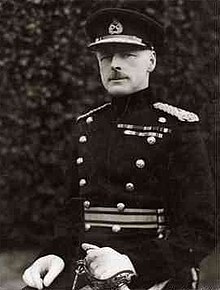Winston Dugan, 1st Baron Dugan of Victoria
KStJ | |
|---|---|
 Sir Winston Dugan as Governor of South Australia in 1934 | |
| 21st Governor of South Australia | |
| In office 28 July 1934 – 23 February 1939 | |
| Monarchs | George V (1934–36) Edward VIII (1936) George VI (1936–39) |
| Premier | Richard Layton Butler (1934–38) Sir Thomas Playford (1938–39) |
| Preceded by | The Earl of Gowrie |
| Succeeded by | Sir Malcolm Barclay-Harvey |
| 18th Governor of Victoria | |
| In office 17 July 1939 – 20 February 1949 | |
| Monarch | George VI |
| Preceded by | Lord Huntingfield |
| Succeeded by | Sir Reginald Brooks |
| Personal details | |
| Born | Winston Joseph Dugan 3 September 1876 Mentioned in Despatches (6) |
Background and education
Dugan was the son of Charles Winston Dugan, of Oxmantown Mall,
Military career
Dugan was a
He later fought with distinction in the
In 1929 he was made a
Governor of South Australia
In 1934, Dugan was appointed
Governor of Victoria
Sir Winston and Lady Dugan arrived in Melbourne on 17 July 1939. They continued their active role in community affairs, promoting unemployment reduction and making the ballroom of Government House, Melbourne available for the Australian Red Cross.[1]
Dugan had an active role stabilising state politics during the tumultuous 1940s. Upon the disintegration of
Dugan's term as governor was extended five times. He was also the Administrator of the Commonwealth on two occasions: from 5 September 1944 to 30 January 1945, between the departure of the governor-general, Lord Gowrie, and the arrival of his successor, Prince Henry, Duke of Gloucester; and from 19 January to 11 March 1947, between the departure of the Duke of Gloucester and the appointment of his successor, William McKell. He returned to England in February 1949. On 7 July 1949 he was raised to the peerage as Baron Dugan of Victoria, of Lurgan in the County of Armagh.[8]
Personal life
Dugan married Ruby Lilian, daughter of Charles Abbott of Kilcaskan, County Cork, in 1912. There were no children from the marriage. He died at Marylebone, London, on 17 August 1951, aged 74.[1] He was buried at All Saints Church, adjacent to the Applewhaite estate, in South Pickenham, Norfolk. [1]
References
- ^ ISSN 1833-7538. Retrieved 24 July 2014.
- ^ Duggan, Eugene (1998). "Duggans of Galway - Their Ancient Origins". Irish Times. Archived from the original on 4 March 2016. Retrieved 17 June 2020.
- ^ "No. 27156". The London Gazette. 23 January 1900. p. 429.
- ^ "The War – Embarcation of Troops". The Times. No. 36090. London. 15 March 1900. p. 10.
- ^ "No. 27441". The London Gazette. 10 June 1902. p. 3752.
- ^ Rose, Captain G.K. (1920). The Story of the 2/4th Oxfordshire and Buckinghamshire Light Infantry (PDF). Oxford: B. H. Blackwell. p. 14.
- ^ "Army Commands" (PDF). Retrieved 17 June 2020.
- ^ "No. 38660". The London Gazette. 8 July 1949. p. 3345.


